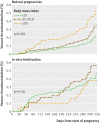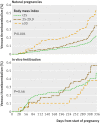Incidence of pulmonary and venous thromboembolism in pregnancies after in vitro fertilisation: cross sectional study
- PMID: 23321489
- PMCID: PMC3546085
- DOI: 10.1136/bmj.e8632
Incidence of pulmonary and venous thromboembolism in pregnancies after in vitro fertilisation: cross sectional study
Abstract
Objective: To estimate the risk of pulmonary embolism and venous thromboembolism in pregnant women after in vitro fertilisation.
Design: Cross sectional study.
Setting: Sweden.
Participants: 23,498 women who had given birth after in vitro fertilisation between 1990 and 2008 and 116,960 individually matched women with natural pregnancies.
Main outcome measures: Risk of pulmonary embolism and venous thromboembolism (identified by linkage to the Swedish national patient register) during the whole pregnancy and by trimester.
Results: Venous thromboembolism occurred in 4.2/1000 women (n=99) after in vitro fertilisation compared with 2.5/1000 (n=291) in women with natural pregnancies (hazard ratio 1.77, 95% confidence interval 1.41 to 2.23). The risk of venous thromboembolism was increased during the whole pregnancy (P<0.001) and differed between the trimesters (P=0.002). The risk was particularly increased during the first trimester, at 1.5/1000 after in vitro fertilisation versus 0.3/1000 (hazard ratio 4.22, 2.46 to 7.26). The proportion of women experiencing pulmonary embolism during the first trimester was 3.0/10,000 after in vitro fertilisation versus 0.4/10,000 (hazard ratio 6.97, 2.21 to 21.96).
Conclusions: In vitro fertilisation is associated with an increased risk of pulmonary embolism and venous thromboembolism during the first trimester. The risk of pulmonary embolism is low in absolute terms but because the condition is a leading cause of maternal mortality and clinical suspicion is critical for diagnosis, an awareness of this risk is important.
Trial registration: ClinicalTrials.gov NCT01524393.
Conflict of interest statement
Competing interests: All authors have completed the ICMJE uniform disclosure form at
Figures




Similar articles
-
Incidence of pulmonary and venous thromboembolism in pregnancies after in vitro fertilization with fresh respectively frozen-thawed embryo transfer: Nationwide cohort study.J Thromb Haemost. 2020 Aug;18(8):1965-1973. doi: 10.1111/jth.14840. Epub 2020 May 11. J Thromb Haemost. 2020. PMID: 32289205
-
Trends in the incidence of venous thromboembolism during pregnancy or postpartum: a 30-year population-based study.Ann Intern Med. 2005 Nov 15;143(10):697-706. doi: 10.7326/0003-4819-143-10-200511150-00006. Ann Intern Med. 2005. PMID: 16287790
-
Venous thromboembolism in relation to in vitro fertilization: an approach to determining the incidence and increase in risk in successful cycles.Fertil Steril. 2012 Jan;97(1):95-100. doi: 10.1016/j.fertnstert.2011.10.038. Epub 2011 Nov 25. Fertil Steril. 2012. PMID: 22118992
-
Pulmonary embolism in pregnancy. Consensus and controversies.Minerva Ginecol. 2012 Oct;64(5):387-98. Minerva Ginecol. 2012. PMID: 23018478 Review.
-
Endometrial scratch to increase live birth rates in women undergoing first-time in vitro fertilisation: RCT and systematic review.Health Technol Assess. 2022 Jan;26(10):1-212. doi: 10.3310/JNZT9406. Health Technol Assess. 2022. PMID: 35129113 Free PMC article. Clinical Trial.
Cited by
-
Pulmonary Embolism After in vitro Fertilization and Cesarean Section: Two Case Reports and Brief Review of the Literature.Int J Womens Health. 2022 Oct 25;14:1489-1497. doi: 10.2147/IJWH.S366355. eCollection 2022. Int J Womens Health. 2022. PMID: 36317008 Free PMC article.
-
Long term all-cause and cardiovascular disease mortality among women who undergo fertility treatment.Med J Aust. 2022 Nov 21;217(10):532-537. doi: 10.5694/mja2.51734. Epub 2022 Oct 9. Med J Aust. 2022. PMID: 36209740 Free PMC article.
-
Risk factors for venous thromboembolism in 1.3 million pregnancies: a nationwide prospective cohort.PLoS One. 2014 May 2;9(5):e96495. doi: 10.1371/journal.pone.0096495. eCollection 2014. PLoS One. 2014. PMID: 24788753 Free PMC article.
-
Guidance for the treatment and prevention of obstetric-associated venous thromboembolism.J Thromb Thrombolysis. 2016 Jan;41(1):92-128. doi: 10.1007/s11239-015-1309-0. J Thromb Thrombolysis. 2016. PMID: 26780741 Free PMC article.
-
Risk of a thrombotic event after the 6-week postpartum period.N Engl J Med. 2014 Apr 3;370(14):1307-15. doi: 10.1056/NEJMoa1311485. Epub 2014 Feb 13. N Engl J Med. 2014. PMID: 24524551 Free PMC article.
References
-
- Van Voorhis BJ. Clinical practice. In vitro fertilization. N Engl J Med 2007;356:379-86. - PubMed
-
- Steptoe PC, Edwards RG. Birth after the reimplantation of a human embryo. Lancet 1978;2:366. - PubMed
-
- The Nobel Assembly at Karolinska Institutet. Human in vitro fertilization, 2010. http://static.nobelprize.org/nobel_prizes/medicine/laureates/2010/adv.pdf.
-
- Malizia BA, Hacker MR, Penzias AS. Cumulative live-birth rates after in vitro fertilization. N Engl J Med 2009;360:236-43. - PubMed
-
- Lindqvist P, Dahlback B, Marsal K. Thrombotic risk during pregnancy: a population study. Obstet Gynecol 1999;94:595-9. - PubMed
Publication types
MeSH terms
Associated data
LinkOut - more resources
Full Text Sources
Other Literature Sources
Medical
